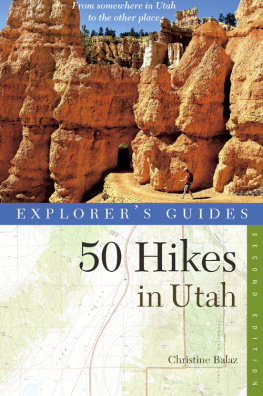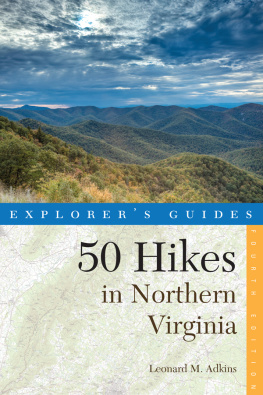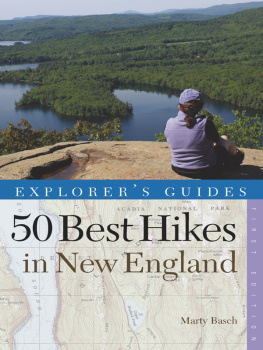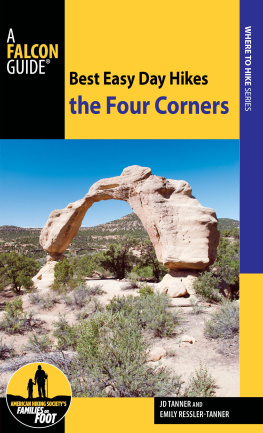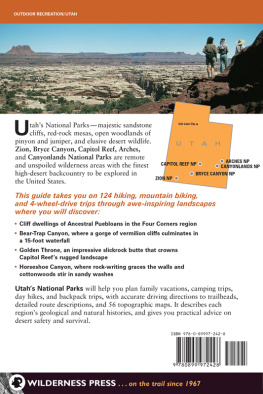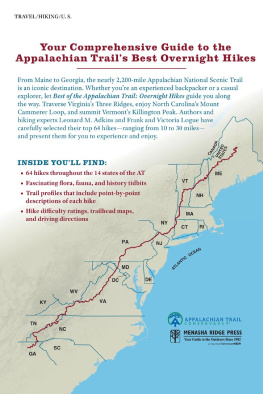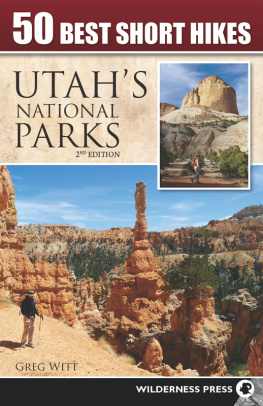AN INVITATION TO THE READER
Over time trails can be rerouted and signs and landmarks altered. If you find that changes have occurred on the routes described in this book, please let us know so that corrections may be made in future editions. The author and publisher also welcome other comments and suggestions. Address all correspondence to:
Editor, 50 Hikes Series
The Countryman Press
P.O. Box 748
Woodstock, VT 05091
Copyright 2013 by Christine Balaz
First Edition
All rights reserved. No part of this book may be reproduced in any form or by any electronic or mechanical means, including information storage and retrieval systems, without permission in writing from the publisher, except by a reviewer, who may quote brief passages.
Explorers Guide 50 Hikes in Utah
97-1-58157-182-0
ISBN 978-1-581-57726-6 (e-book)
Maps by Erin Greb Cartography, The Countryman Press
Book design by Glenn Suokko
Text composition by Perfec Type, Nashville, TN
Interior photographs by the author unless otherwise specified
Published by The Countryman Press,
P.O. Box 748, Woodstock, VT 05091
Distributed by W. W. Norton & Company, Inc.,
500 Fifth Avenue, New York, NY 10110
Printed in the United States of America
50 Hikes in Utah at a Glance




Introduction

ABOUT THIS BOOK
This book contains a broad variety of day hikes spanning from the Bear River Range of northern Utah to the Salt Lake Cityarea canyons and Zion National Park. The hikes in this book range from 1 to 13 miles in length, and contain as little as 100 feet of elevation gainor as much as 3,000 feet. The routes tour through high-alpine terrain, canyon forests, low-elevation deserts, and everything in between. Seeing it unfit to combine multiday backpacking journeys with 3-mile outings, I intentionally kept all of the hikes within a one-day distance.
Additionally, I often clumped multiple hikes together with the idea that people traveling somewhere to hikeparticularly to some of Utahs most beautiful areaswould likely want to explore the destination more than just one hike would allow. So if youre planning a trip to the Logan area, for example, youll find yourself with a good selection of hikes, all within 45 driving minutes of each other.
Though geographical variety is important, this book does not include variety for varietys sake alone. That is, if a region of Utah is truly too bland, flat, remote, or otherwise less-than-ideal for hiking, I did not force it into the book. After all, narrowing Utahs hikes down to a selection of just 50 is already a challenging task. I saw no need to dilute these hikes with lower-quality or logistically unfeasible alternatives simply in the name of spreading out dots on a map.
MOUNTAINS, CANYONS, DESERTS, AND BASINS: UTAHS GEOLOGY
With the exception of perhaps California, Utah arguably has the most diverse geography of any state in the United States. Within its boundaries stand burnt-orange sandstone arches, towering alpine peaks, and vast desert salt flats. Standing as low as 2,180 feet at Beaver Dam Wash, and as high as 13,528 feet at Kings Peak in the Uinta Mountains, this state contains more than 2 vertical miles of relief. And with an area of nearly 85,000 square miles, its spans 5 degrees of latitude and 5 degrees of longitude.
Utahs northern half is largely dominated by major mountain ranges and broad valleys standing between them. The Wasatch Mountains, possibly Utahs most famous range, run from southern Idaho past Logan and Salt Lake City to just south of Provo. This mountain range is considered to be the westernmost portion of the Rocky Mountains, which stretch eastward all the way to Denver. West of the Wasatchs stands the Great Basin, with its enormous salt flats, scattered mountain ranges, andof coursethe Great Salt Lake.
The Uinta Mountains, Utahs tallest range, occupy the northeastern corner of the state. A rarity in North America, this enormous range actually runs from the east to the west (rather than from the north to the south). In fact, the Uintas are the tallest range in the contiguous U.S. that have this alignment, with peaks ranging from 11,000 to 13,528 feet in elevation.
In this northern half of Utah, trails typically tour mountainous terraincovered with evergreen forests and aspen groves, open meadows, and above-timberline scree. Yet there are exceptions. The trails of Antelope Island explore an utterly different environmentthat of a stark and otherworldly desert.
The southern portion of Utah is largely dominated by the geologically famous Grand Staircase. Containing roughly 9,000 vertical feet of relief, this enormous geological feature runs from Cedar Breaks National Monument in the north to the Grand Canyon in the south. From Cedar Breaks, it descends in colorful strata past Bryce Canyon; the Pink and Grey Cliffs; Kolob and Zion Canyons; and the White, Vermillion, and Chocolate Cliffs.
Trails in this southern portion of the state vary enormously. Like those of northern Utah, they can be of lofty, thin-aired elevations. However, they can just as likely tour sunbaked, low-elevation slickrock.
No matter where you find yourself in this state, prepare yourself for a pleasant experience by dressing properly and carrying plenty of food and water. Generally speaking, this is high, dry, and big countrywhether youre in the desert or on a mountain.
TIPS FOR HIKING AND WELL-BEING
Clothing
In a state that regularly sees a temperature range in excess of 120 degrees Fahrenheit, there is obviously no single suggestion that will cover this subject. However, it is safe to say that synthetic materials and wool are universally the best choice. In hot and cold, dry and wet weather, these wick sweat and insulate no matter what. Furthermore, loose, shade-giving clothing breathes well and provides protection from the sun.
Especially on longer or steeper hikes, you would be wise to carry a spare pair of socks in your pack. To avoid blisters while hiking, I wear wool or synthetic socks and typically change into a dry pair halfway into the hikeafter letting my feet air out for a few minutes.
Finally, even on the hottest of days, it never hurts to throw a jacket, hat, and pair of gloves into your packespecially when hiking in the mountains. Nearly all of the trails in this book climb in their first half, and then descend in their second. This means that during the first half of the trip, hikers work up a sweat. But upon reaching higher elevations, they turn downhill and reduce their exertion significantly. This lessened effort, combined with accumulated sweat and cooler, high-altitude temperatures, can render a jacket quite handy.

